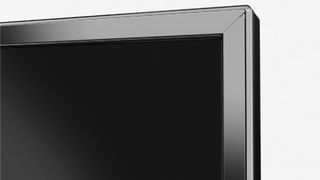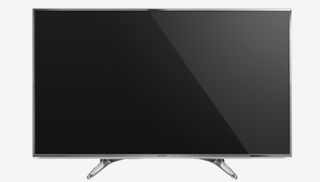Why you can trust TechRadar
The main question here is whether the 55DX650's combination of direct LED lighting and Panasonic picture know-how can counter the picture quality issues inherent to the IPS panel at its heart. And the short answer, sadly, is that it can't.
As soon as you watch any dark movie or TV scenes it becomes blatantly obvious that the screen can't deliver anything close to a natural, deep black colour, leaving such scenes looking greyed over, flat and distractingly unnatural. The greyness hides some shadow details in dark areas too, making them look hollow and unconvincing.
Compare and contrast
If you want to see just how poor by modern standards the 55DX650's native black level performance is, turn off the TV's Adaptive Backlight feature and leave the backlight set to the sort of default levels most of the TV's picture presets recommend. The degree of low-contrast greyness infiltrating the pictures at these settings is painful by 2016 standards.

The only way to make the black level performance in any way workable is to push the Adaptive Backlight feature to its very highest setting, and to greatly reduce the TV's backlight setting. I personally felt I had to reduce the backlight to barely a third of its maximum value before the pervasive greyness became suitably subdued.
Dark destroyer
I guess it's good news that the TV has the tools to provide at least some solution to its inherent contrast woes. However, before you say "that's okay then" and move along, it's worth reflecting that removing more than 60% of the brightness from the picture leaves you with a picture which isn't very, well, bright. This denies colours the pop and vibrancy I like to see even on affordable LCD TVs these days, as well as worsening the issues with lost shadow detail.

There's another issue too. Namely that running the Adaptive Backlight on its highest level can cause some pretty distracting moments of brightness shifting as the brightness of the image content changes.
The 55DX650's problems with black level reproduction don't only affect blacks, unfortunately. The pervasive greyness also lies across colours, reducing their intensity and naturalism, especially – though not exclusively – during dark scenes. Plus, as noted earlier, having to remove so much brightness from the picture to boost black levels leaves colours looking rather muted and flat by 2016 standards.
A few good points
At this stage I ought to point out that the 55DX650 is not all bad. For starters, while colours lack punch once you've adjusted the image to account for the black level problems, they do also look surprisingly refined, with plenty of finesse in the way even the smallest tone or shading differences are resolved. There's an impressively balanced feel to the colour palette too, which ensures no tones look too dominant.
The 55DX650 also does a respectable job of delivering on its native UHD resolution. With native UHD sources there's a clear boost in clarity and detail over HD, despite the screen's affordability. Even more surprising for the money is the quality of the upscaling processing used to convert HD sources to the screen's UHD resolution. This processing is clever enough to add detail without exaggerating source noise or compromising colour tones, resulting in upscaled images that wouldn't look out of place on a 4K TV costing twice as much.
Upscaling standard definition content turns out to be a bit of a stretch – but the same can be said, in truth, of pretty much every 4K TV.
Motion and gaming
Contributing to the 55DX650's sense of sharpness is some good motion reproduction for such an affordable big-screen 4K TV. Movement in the image and camera pans aren't immune to judder and blur, but it's pretty low in intensity compared to much of the similarly-priced competition.
The 55DX650 may appeal to video gamers, meanwhile, thanks to an admirably low input lag reading of around 30ms. This amounts to barely a frame of delay in the time it takes the screen to render images, which shouldn't be enough to cause too many deaths in fast-response games. Before gamers get too excited, though, I would say that the screen's contrast issues don't make games that feature lots of dark nooks and crannies particularly enjoyable.

There are times – essentially when you're watching bright content in a fairly bright room, since ambient light does a good job of reducing the native contrast issues – when the 55DX650's strengths win the day. Unfortunately, though, it's the various problems associated with the TV's IPS LCD panel that crop up regularly and aggressively enough to become its defining feature.
Usability
When it comes to day-to-day use the 55DX650 is a doddle to use, thanks to the attractive, logical and customisable design of the Firefox TV interface. The remote control is reasonably easy to learn your way around too, despite being more laden with buttons than many of today's TV handsets.
You do need to put some up-front effort in with Firefox TV to customise its home page to suit your needs, though, and if you're anything like me you may find yourself regularly paying frustrating visits to the picture set-up menus to try and better solve the screen's backlight problems.
Sound
Despite its fairly slender and stylish design – which doesn't feature any forward-firing speakers – the 55DX650 sounds pretty respectable. It can go loud without the chassis rattling or the speakers crackling or dropping out, it delivers good treble detailing without sounding harsh or dominant, and it even manages a bit of bass without that bass sounding thuddy, or causing voices to sound muddy.
The key audio mid-range that invariably gets the most hammer with a TV audio system sounds open and clean, and even manages to shift up a couple of gears to embrace action scenes when required.
AV Technology Contributor
John has been writing about home entertainment technology for more than two decades - an especially impressive feat considering he still claims to only be 35 years old (yeah, right). In that time he’s reviewed hundreds if not thousands of TVs, projectors and speakers, and spent frankly far too long sitting by himself in a dark room.

Meta’s massive OS announcement is more exciting than a Meta Quest 4 reveal, and VR will never be the same again

World's fastest broadband connection went live down under — Nokia demos 100 gigabit internet line in Australia in record-breaking attempt but doesn't say when it will go on sale

Don't miss the Samsung Galaxy S23 Ultra for just $849 at Best Buy right now

